Other common names:
- Annual sowthistle: sowthistle, smooth sowthistle, hare’s lettuce, hare’s colewort, milk thistle
- Spiny sowthistle: spiny-leaved sowthistle, sharp-fringed sowthistle, prickly sowthistle, rough milk thistle, rough sowthistle, chaudronnet (Quebec)
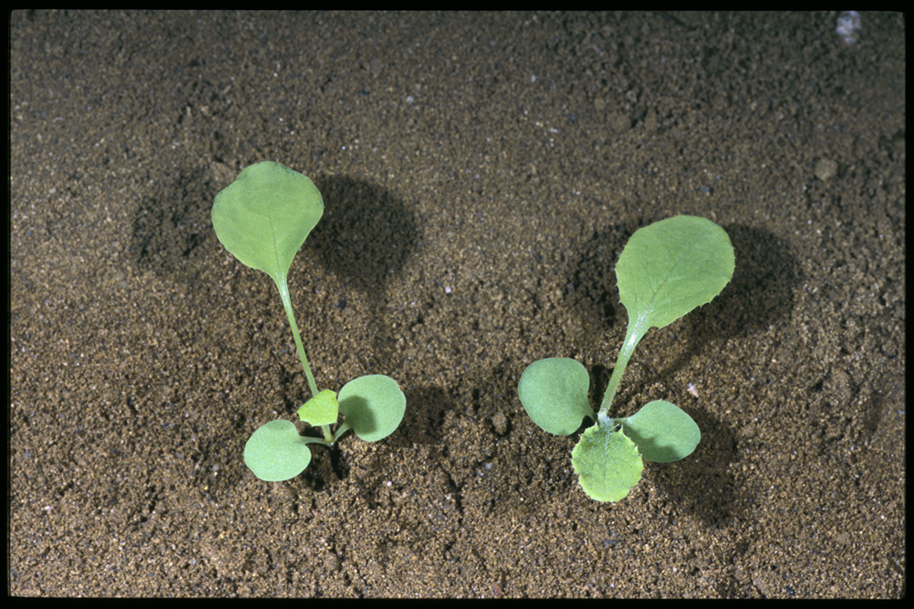
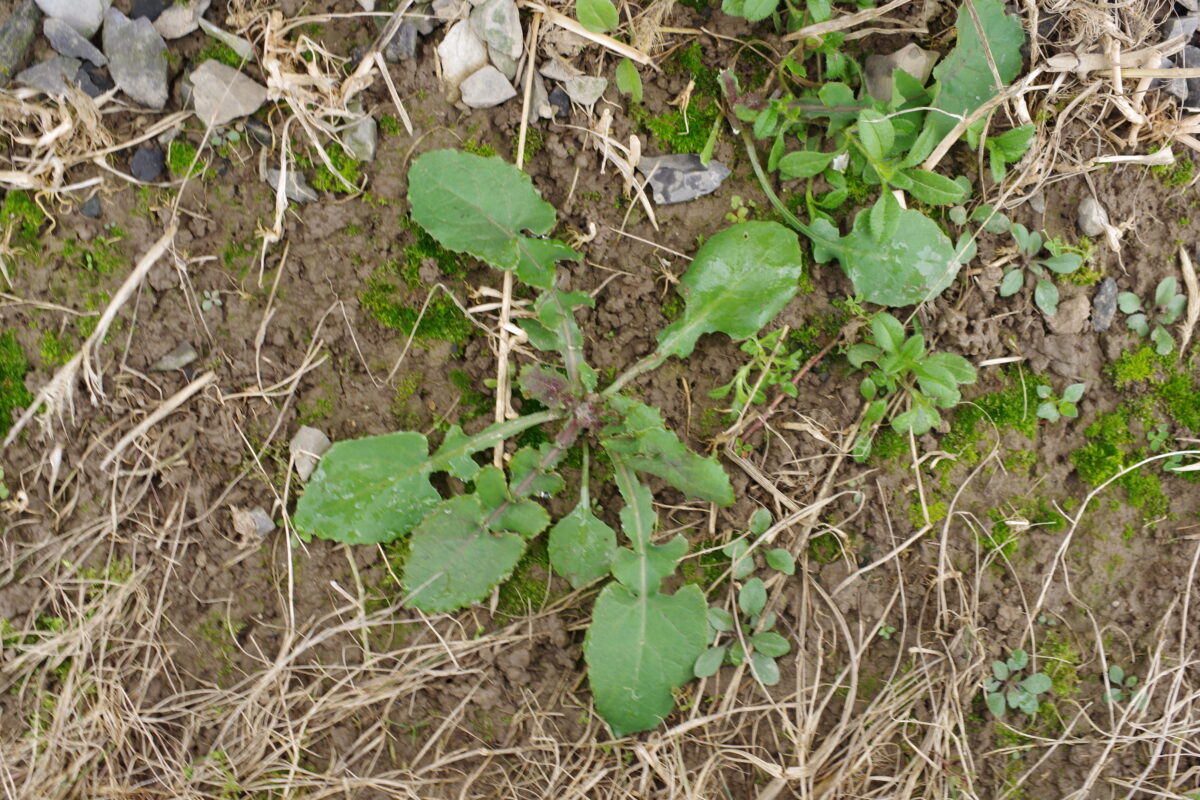
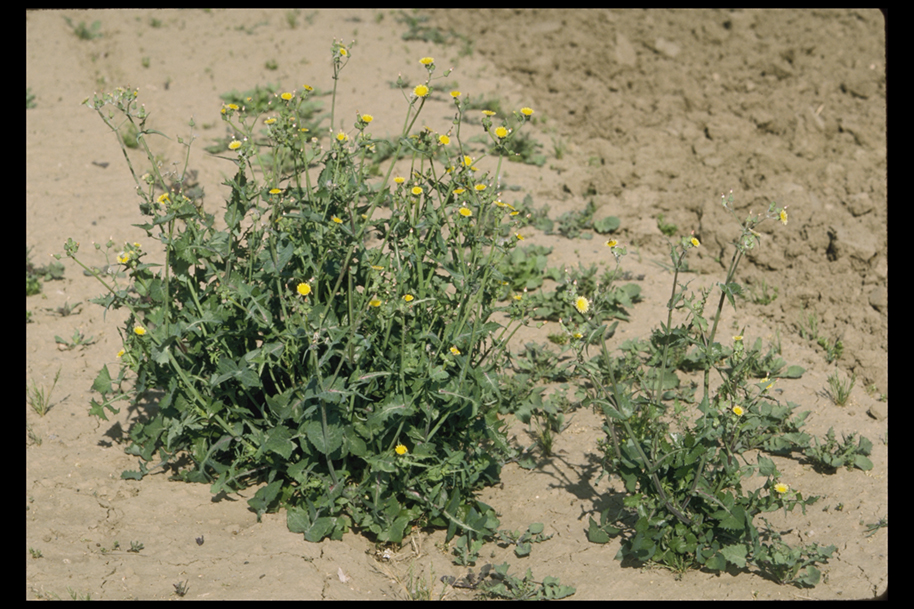
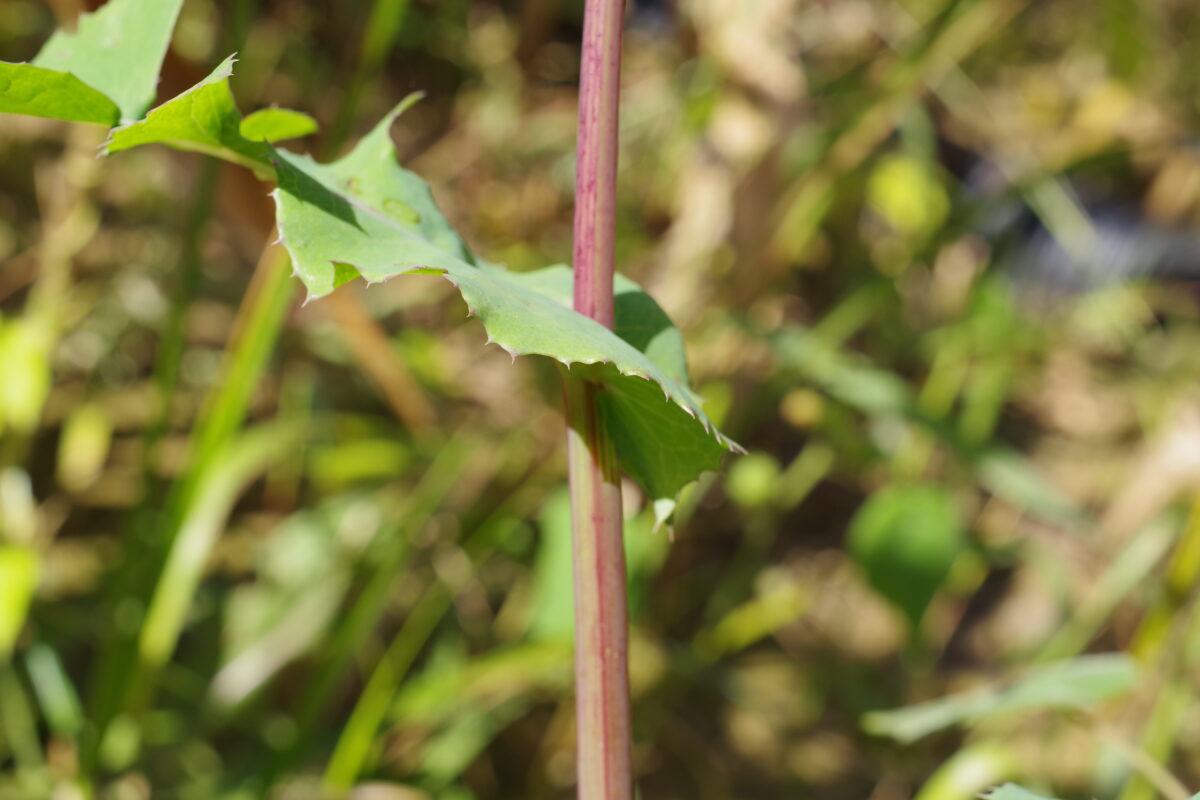
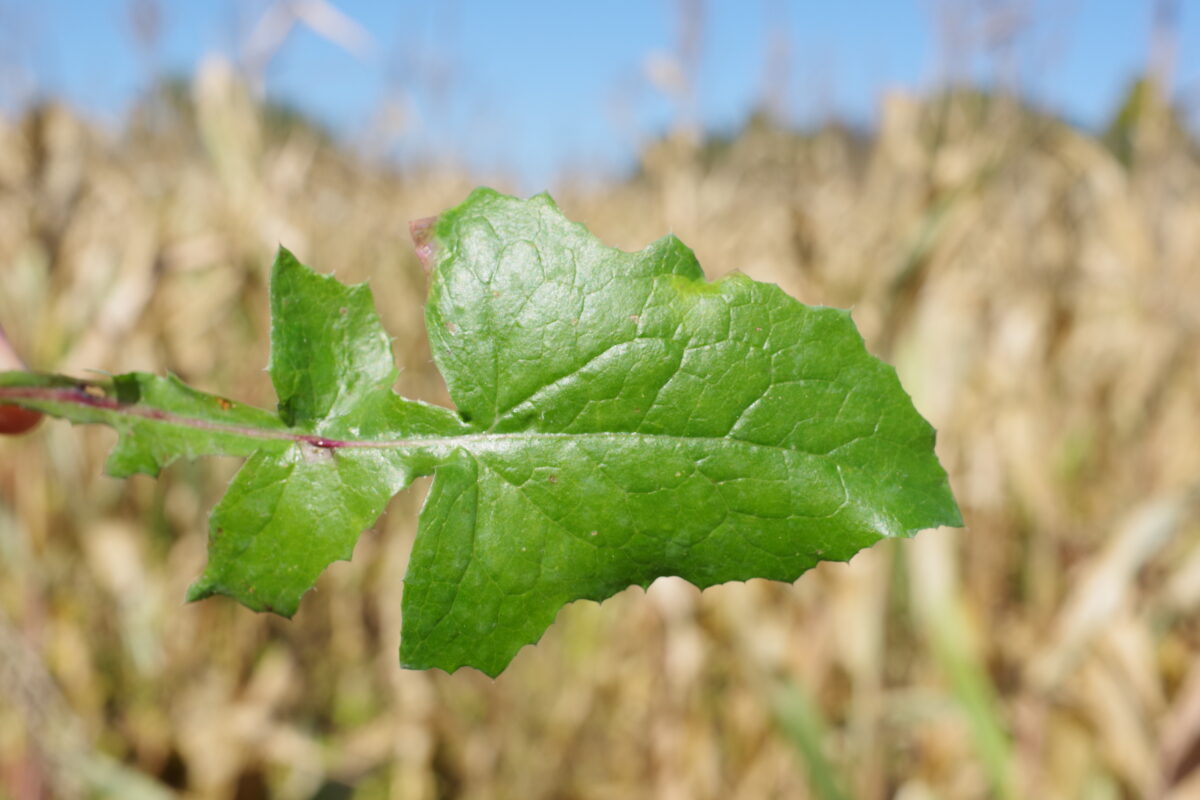
Annual sowthistle, Sonchus oleraceus L.
Spiny sowthistle, Sonchus asper (L.) Hill
Identification of Annual Sowthistles
Family: Aster family, Asteraceae
Habit: Erect summer or winter annual herbs
Description: Seedlings form alternate-leaved rosettes before bolting. Cotyledons are hairless, have short stalks and are circular to egg shaped. The first true leaves are sparsely hairy, stalked and are circular to spatula shaped. By the four-leaf stage seedlings exude a milky sap when damaged.
- Annual sowthistle: Cotyledons are 0.16–0.31 inch long by 0.06–0.16 inch wide. The first true leaves have irregularly toothed edges. Later leaves are oval to egg shaped, irregularly lobed and have winged stalks.
- Spiny sowthistle: Cotyledons are 0.14–0.24 inch long by 0.06–0.16 inch wide. The first true leaves have downward facing, spiny teeth along the edges. Subsequent leaves are oval to lanceolate with wavy and spiny edges and short stalks.
Mature plants reach 1–5 feet tall on upright, hairless, hollow stems that branch occasionally towards the top. Leaves are alternate and smooth, and clasp the stem at the base. All parts exude milky sap when damaged. The root system is a short taproot.
- Annual sowthistle: Leaves are dull green to blue-green, deeply lobed, 2.4–12 inches long by 0.4–6 inches wide and clasp the stem at the base with a pair of angular lobes. The leaves generally have a triangular to lanceolate lobe at the tip and three or fewer paired lobes on the lower portion of the leaf. Lobes may be reduced or absent on the upper leaves. Leaf edges are irregularly toothed and may have soft spines. Leaves are deeply divided, reaching almost to the midrib. Acute auricles are uneven and slanted.
- Spiny sowthistle: Leaves are glossy, green to purplish, oval to lanceolate or occasionally lobed, 2–10 inches long by up to 3 inches wide and clasp the stem at the base with a pair of rounded, spiny lobes. Leaf edges are wavy and covered in sharp, prickly spines. Leaves are not as deeply divided as those of annual sowthistle. Leaves lack stalks but have distinct, large, “rams-horn” auricles clasping the stem.
Flowers are yellow and produced in clusters of one to five flower heads at the ends of stems and branches. The flower head stalks may be smooth or covered in gland-tipped hairs. Each flower head is 0.4–1 inch wide and has up to 250 petals. At the base of each flower head are three to five rows of green, overlapping bracts. Seeds are covered with a hard, dry layer of fruit tissue. Seeds are oval to oblong, flattened and have three to five longitudinal ridges on each side. Each seed is attached to a feathery, white pappus up to 0.3 inch long.
- Annual sowthistle: Seeds are brown to olive, finely wrinkled, never winged and are 0.08–0.16 inch long by 0.04 inch wide.
- Spiny sowthistle: Seeds are light brown, smooth, often winged on the edges and 0.08–0.1 inch long by 0.06 inch wide.
Similar species: Perennial sowthistle (Sonchus arvensis L.) and prickly lettuce (Lactuca serriola L.) both have milky sap and similar foliage and flowers to spiny annual and annual sowthistle. Perennial sowthistle has larger flowers (1–2 inches wide) than either species and has an extensive, spreading system of perennial storage roots rather than a taproot. Prickly lettuce leaves have prominent spines along the midrib, while the midribs of spiny and annual sowthistle leaves lack such spines. Oxtongue (Picris) species have similar flowers and habits to spiny and annual sowthistle. The stems and leaves of oxtongues are covered with short, stiff hairs, while those of spiny and annual sowthistle are smooth.
Management of Annual Sowthistles
Annual and spiny sowthistles can act as either spring or winter annuals, making them adapted to both fall- and spring-sown crops. Thus, they are less easily controlled by rotation between crops with different growing seasons than most other weed species. They tend to be particularly abundant and prone to seed production in winter grains. Since germination is favored by light and seedling emergence is limited to the surface 0.4 inch of soil, they are particularly prevalent in no-till systems. A moderately long period in the rosette stage makes sowthistles susceptible to suppression by crops that cast heavy shade and by organic mulch materials. Grain crops planted at high density and narrow rows decrease growth potential of these weeds. The long rosette stage also makes them relatively easy to bury with aggressive tine weeding or by throwing soil into the crop row. Shallow cultivation either in a bare fallow or after planting the crop is effective for flushing out and destroying seedlings. Since the seed bank is relatively short lived, inversion tillage is useful for controlling these species, especially after a season with abundant seed production, provided subsequent inversion tillage does not occur for 30 months. Mowed field edges, cleared stream banks and other non-forested habitats can prevent spread into adjacent fields.
Ecology of Annual Sowthistles
Origin and distribution: Annual and spiny sowthistle likely originated near the Mediterranean Sea. Spiny sowthistle has been introduced into North and South America, Africa, Australia, New Zealand and south and east Asia. Annual sowthistle is similarly widespread. Both species occur throughout most of the United States and southern Canada, and spiny sowthistle occurs northward into central Alaska and the Yukon.
Seed weight: Population mean seed weights range from 0.27–0.42 mg for annual sowthistle and 0.3–0.41 mg for spiny sowthistle.
Dormancy and germination: A high percentage of annual sowthistle seeds will germinate immediately after dispersal if they receive light. They emerge considerably better in light than in dark or with only a pulse of light. Germination was good at a fluctuating day/night temperature of 77/50°F, but neither species germinates well at any constant temperature according to one report. However, non-dormant annual sowthistle germinated well at a wide range of constant temperatures from 41–95°F in another report. High moisture levels are required for optimum germination of annual sowthistle. Some germination can occur at moderate salt concentrations and high pH levels greater than 8. Spiny sowthistle germinates well in light immediately after seed collection but acquires a capacity to partially germinate in dark after six months. Cold (43°F), wet conditions decrease spiny sowthistle seed dormancy but germination after 18 weeks of cold stratification is still greater in light than in dark.
Seed longevity: In soil stirred three times a year, annual sowthistle seeds declined by 48–65% per year. For spiny sowthistle, seeds declined by 48–62% per year. Mortality of annual sowthistle seeds was 82% when left on the soil surface for almost eight months through the Australian winter, whereas mortality was 55% for seeds buried 2 inches. In another Australian experiment, annual sowthistle seed mortality was greater than 99% after one year at the soil surface but was 53% when buried 4 inches. Some buried seeds of annual sowthistle lasted for at least five years.
Season of emergence: In cooler climates, most emergence of both species takes place in mid- to late spring, but some seedlings emerge throughout the growing season whenever conditions are favorable for germination. Emergence is greatest at daily maximum and minimum temperatures of 54/39°F to 66/50°F. In warm climates, particularly Mediterranean climates with hot, dry summers, annual sowthistle can behave as a winter annual, with a flush of emergence following planting of fall-sown crops. Because annual sowthistles lack dormancy when exposed to light and they germinate over a wide range of temperatures given sufficient soil moisture, emergence occurs throughout the spring and summer in moist climates, but only during the winter season in Mediterranean climates.
Emergence depth: Emergence of annual sowthistle is best from 0–0.4 inch, with little emergence from 0.8–1.2 inch. Up to 77% of annual sowthistle seeds will germinate on the soil surface. Seeds probably emerge well from the soil surface because the flat shape of the seed allows for good soil contact and water uptake.
Photosynthetic pathway: C3
Sensitivity to frost: Young plants of both species are highly frost tolerant. Fall emerging individuals overwinter as a rosette of leaves close to the ground and can withstand temperatures several degrees below 0°F. In the Canadian prairies and northward, however, the species overwinter only as seeds. Flower buds are killed by early frost, and flowering plants are partially killed by frost.
Drought tolerance: Annual sowthistle can survive short periods of drought that are sufficiently severe to cause wilting of the leaves. Spiny sowthistle is sensitive to drought stress. Plants watered three times per week grew only half as large as those that were watered daily, and plants watered only once per week failed to reproduce.
Mycorrhiza: Annual sowthistle is strongly mycorrhizal, but spiny sowthistle, although listed as mycorrhizal on disturbed sites in Utah, has a low rate of mycorrhizal infection.
Response to fertility: Annual sowthistle tolerates low N fertility well. It occurs on soils with pH from 6.5–9 and does best at pH over 8. Since P would have very low availability in the high pH conditions in which annual sowthistle thrives, it apparently also tolerates low P. Spiny sowthistle tolerates low fertility well. In one experiment it actually produced more seeds when unfertilized than when given 10-10-10 fertilizer before planting. Nevertheless, another study found that this species had three times the concentration of K and twice the concentration of P and Ca as a barley crop in which it was growing.
Soil physical requirements: Both species occur on a wide range of soil textures from clay to sand. Both species tolerate salt and alkaline soils provided moisture is available.
Response to shade: Annual and spiny sowthistle do not tolerate more than light shade.
Sensitivity to disturbance: Since the leaves of the young plants remain flat on the soil in a rosette for several weeks, they are highly susceptible to burial, as with aggressive tine weeding or when soil is thrown into the crop row. They do not tolerate trampling but can grow new stems if the first stems are broken or cut. Plants cannot regrow from the taproot alone. Plants of annual sowthistle cut at the flowering stage are still able to produce viable seeds.
Time from emergence to reproduction: Annual sowthistle emerging in early spring will flower in June, but overwintering rosettes will begin producing flower stems in March. In warm weather on poor soil, annual sowthistle can flower in as little as six weeks. Spring emerging spiny sowthistle flowers about nine weeks after emergence with the seeds ripening about one week later.
Pollination: Both species self-pollinate but are probably also cross pollinated to some extent by small bees and flies.
Reproduction: A sample of 65 British annual sowthistles produced an average of 140 seeds per head and 44 heads per plant, for a total of 6,100 seeds per plant. A sample of 25 spiny sowthistles averaged 200 seeds per head and 105 heads per plant for a total of 23,000 seeds per plant.
Dispersal: Tufts of hairs help the seeds to disperse long distances on air currents. These hairs also tangle in fur, feathers and clothing, causing the seeds to be carried by animals and humans. Seeds of annual sowthistle have been found adhering to feet and feathers of waterfowl. The seeds of spiny sowthistle (and probably annual sowthistle as well) pass through cattle and are spread with the manure. The seeds also float well and disperse along streams and lakeshores. Annual and spiny sowthistle seeds found in irrigation water had germination rates of 22% and 57%, respectively.
Common natural enemies: Sowthistles are attacked by several species of leaf mining fly larvae. They are susceptible to downy mildew caused by Bremia lactucae, which also infects commercial lettuce.
Palatability: European peoples have used sowthistles as a pot herb since ancient times. The content of minerals, vitamins and antioxidants in these species is similar to those of leafy vegetables. The foliage is palatable to livestock, though most animals have difficulty eating immature plants because the leaves lie flat on the ground.
Summary Table of Annual Sowthistles Characteristics
| Annual Sowthistle | ||||||||
|---|---|---|---|---|---|---|---|---|
| Growth habit | Seed weight (mg) | Seed dormancy at shedding | Factors breaking dormancy | Optimum temperature for germination (F) | Seed mortality in untilled soil (%/year) | Seed mortality in tilled soil (%/year) | Typical emergence season | Optimum emergence depth (inches) |
| medium, branched | 0.27–0.42 | No | li | 41–95 | 53–55 | 48–65 | spring, summer, fall | 0–0.4 |
| Photosynthesis type | Frost tolerance | Drought tolerance | Mycorrhiza | Response to nutrients | Emergence to flowering (weeks) | Flowering to viable seed (weeks) | Pollination | Typical & high seed production (seeds per plant) |
| C3 | high | low | yes | low | 6–9 | 1 | self | na & 20,000 |
Table Key
Drought tolerance: Relative tolerance of aboveground plants to drought (high, moderate, low).
Emergence period from perennial organs: Time of year when most emergence occurs from perennial overwintering organs in the typical regions of occurrence for each weed. Some emergence may occur outside of this range.
Emergence to flowering: Length of time (weeks) after emergence from perennial organs to the beginning of flowering in the typical regions of occurrence. Note that this refers to established perennial plants, recognizing that some species may not flower in their initial year of establishment.
Factors breaking dormancy: The principle factors that are reported to break dormancy and facilitate germination. The order of listing does not imply order of importance. Abbreviations are:
- scd = seed coat deterioration
- cms = a period subjected to cold, moist conditions
- wst = warm soil temperature
- li = light
- at = alternating day-night temperatures
- ni = nitrates"
Flowering to viable seed: Length of time (weeks) after flowering for seeds to become viable.
Frost tolerance: Relative tolerance of aboveground shoots to freezing temperatures (high, moderate, low).
General: The designation "-" signifies that data is not available or the category is not applicable
Growth habit: A two-word description. The first word indicates relative height (tall, medium, short, prostrate) and the second word indicates degree of branching (erect, branching, vining)
Importance of seeds to weediness: The relative importance of seeds to dispersal, genetic diversity and survival of the species as a weed in agricultural environments (high, moderate, low).
Mycorrhiza: Presence of mycorrhizal fungi. “Yes” if present; “no” if documented not to be present, “unclear” if there are reports of both presence and absence; “variable” if the weed can function either with or without, depending on the soil environment.
Optimum emergence depth from perennial organs: Soil depths (in inches below the soil surface) from which most shoots emerge from perennial organs. Lower rates of emergence usually will occur at depths above or below this range.
Optimum temperature range for germination: Temperature (Fahrenheit) range that provides for optimum germination of non-dormant seeds. Germination at lower percentages can occur outside of this range. The dash refers to temperature range, and the slash refers to alternating day/night temperature amplitudes.
Perennial overwinter organ: Principal plant organ that survives winter and from which growth resumes in subsequent years.
Photosynthesis type: Codes “C3” or “C4” refer to the metabolic pathway for fixing carbon dioxide during photosynthesis. Generally, C3 plants function better in cooler seasons or environments and C4 plants function better in warmer seasons or environments.
Pollination: “Self” refers to species that exclusively self-pollinate; “cross” refers to species that exclusively cross-pollinate; “self, can cross” refer to species that primarily self-pollinate, but also cross-pollinate at a low rate; and “both” refers to species that both self-pollinate and cross pollinate at relatively similar rates.
Response to nutrients: Relative plant growth response to the nutrient content of soil, primarily N, P, K (high, moderate, low).
Seed dormancy at shedding: “Yes” if most seeds are dormant when shed; “Variable” if dormancy is highly variable; “No” if most seeds are not dormant.
Seed mortality in tilled soil: Range of mortality estimates (percentage of seed mortality in one year) for seeds in tilled soil. Values were chosen for seeds placed within the tillage depth and subjected to at least annual tillage events. Seed losses are the result of dormancy-breaking cues induced by tillage, germination and deterioration of un-germinated seeds.
Seed mortality in untilled soil: Range of mortality estimates (percentage of seed mortality in one year) for buried seeds in untilled soil. Values were chosen where possible for seeds placed at depths below the emergence depth for the species and left undisturbed until assessment. Mortality primarily represents seed deterioration in soil.
Seed weight: Range of reported values in units of “mg per seed."
Time/stage of lowest reserves: Time of year and/or weed growth stage at which carbohydrate reserves are lowest. This usually corresponds to the time when the weed is most susceptible to weed management operations.
Typical and high seed production potential: The first value is seed production (seeds per plant) under typical conditions with crop and weed competition. The second value, high seed production, refers to conditions of low density without crop competition. Numbers are rounded off to a magnitude that is representative of often highly variable reported values
Typical emergence season: Time of year when most emergence occurs in the typical regions of occurrence for each weed. Some emergence may occur outside of this range.
Weed: Weed common name as listed in the Weed Science Society of America Composite List of Weeds, presented in alphabetical order
Further Reading
Hutchinson, I., J. Colosi and R.A. Lewin. 1984. The biology of Canadian weeds. 63. Sonchus asper (L.) Hill and S. oleraceus L. Canadian Journal of Plant Science 64: 731–744.
Lewin, R.A. 1948. Biological Flora of the British Isles. Sonchus L. (Sonchus oleraceus L. and S. asper (L.) Hill). Journal of Ecology 36: 203–223.
Widderick, M.J., S.R. Walker, B.M. Sindel and K.L. Bell. 2010. Germination, emergence, and persistence of Sonchus oleraceus, a major crop weed in subtropical Australia. Weed Biology and Management 10: 102–112.

